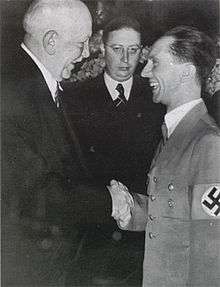Heinz Drewes
Heinz Drewes (1903–1980) was a German conductor and in 1937–1944 head of division X (music) of Reichsministerium für Volksaufklärung und Propaganda[1] at the time when Reichsmusikkammer was led by Peter Raabe from 1935 onwards.[2][3] He was one of the most influential people in German music world at that time.[4] Drewes was head of division X (music) subordinated divisions: Reich Music Examination Office, Reichsstelle für Musikbearbeitungen, Auslandsstelle für Musik, Amt für Konzertwesen.

Career
Drewes and Raabe struggled on "the leadership in music," and this made Joseph Goebbels happy as he could use their words as a threat to one or the other.[5]
Drewes worked in Deutsches Nationaltheater und Staatskapelle Weimar as a répétiteur and conductor. In 1930 he went in Landestheater in Altenburg (Theater & Philharmonie Thüringen) as a conductor. He started there a local chapter for KfdK (Kampfbund für deutsche Kultur) and the same year he went in NSDAP and wrote articles in NS-Zeitung and Völkischer Beobachter.[6] Deutscher Musiker-Kalender tells in 1943 he was Generalintendant and Generalmusikdirektor.[7]
Denazified Drewes worked after the war in Nürnberg Conservatory. Later a story emerged that Drewes used pseudonyms as he conducted when working in the propaganda ministry. He conducted only with the radio orchestras. It was he who hired and fired the conductors. He may have used the name Hermann Desser when he conducted Felix Draeseke's Symphonia Tragica with Berlin Symphony Orchestra, published in 1955 by Urania Records. Alan Krueck says there is no such conductor as Hermann Desser, and the music was typical for the Third Reich and on the other hand the quality of the recording was consistent with that achievable at the time. Later Christoph Schlüren also identifies Drewes.[8]
Drewes appreciated Jean Sibelius and was the president of the German Sibelius Society (Deutsche Sibelius Gesellschaft). He wrote a preface to Ernst Tanzberger's dissertation Die symphonischen Dichtungen, von Jean Sibelius, eine inhalts- und formanalytische Studie (K. Triltsch, 1943). Tommi Mäkelä writes in his Sibelius biography that it was explicitly meant to be a greeting 'to our Finnish friends and comrades-in-arm.'[9] Drewes himself writes that the symphonic sagas of Sibelius evidence that "while the Finnish Volk could be counted racially among the Finno-Ugric tribe," over centuries it had "turned happily toward the German world".[10]
Drewes was a friend of Richard Strauss, who asked him extend his protection to Strauss' libretist Joseph Gregor.[11] Strauss again asked protection in 1939 to his non-Aryan daughter-in-law and grandchildren.[12]
The Swedish composer Kurt Atterberg was worried about the German conductor Helmuth Thierfelder whether he could conduct Attenberg's compositions, and about his possibilities to visit Sweden.[13]
The concertmaster of Philharmonischen Orchester Landestheater Coburg Ralph Braun says the significance of Drewes has not been known until today.[1]
References
- Ralph Braun. "Die "Bedeutung" von Dr. Heinz Drewes" (in German). Ralph Braun. Retrieved 31 Jan 2015.
- Marc Brüninghaus. "Unterhaltungsmusik im Dritten Reich" (in German). Google-books. p. 27. Retrieved 31 Jan 2015.
...er sorgte dafür, dass Richard Strauss 1935 sein Amt als Präsident der Reichsmusikkammer niederlegen musste...
- Charles Youmans. "The Cambridge Companion to Richard Strauss". Cambridge Companions to Music. Google Books. p. 237. Retrieved 31 Jan 2015.
...Strauss had become a pawn in the power struggle between Goebbels and Alfred Rosenberg, Goebbels rival in matters of cultural politics...
- Ralph Braun. "NS-Musik-Propaganda" (pdf) (in German). Retrieved 31 Jan 2015.
- Michael H. Kater. "The Twisted Muse: Musicians and Their Music in the Third Reich". New York Times. Retrieved 31 Jan 2015.
- Nina Okrassa. "Peter Raabe: Dirigent, Musikschriftsteller und Präsident der ..." (in German). Retrieved 31 Jan 2015.
- Deutscher Musiker-Kalender 1943
- "Felix Draeseke and Urania". Retrieved 31 Jan 2015.
- Tomi Mäkelä. "Jean Sibelius". Retrieved 31 Jan 2015.
- David B. Dennis. "Inhumanities: Nazi Interpretations of Western Culture". Google Books s. 285. Retrieved 31 Jan 2015.
- Michael H. Kater (2000). Composers of the Nazi Era: Eight Portraits. Internet Archive, sivut 163, 250. p. 163. Retrieved 31 Jan 2015.
- Charles Youmans. "The Cambridge Companion to Richard Strauss" (pdf). Cambridge University Press. Retrieved 31 Jan 2015.
- Petra Garberding (2008). "Musikutbyte som politiskt slagträ? Kurt Atterberg och Helmuth Thierfelder". Svensk tidskrift för musikforskning (in Swedish). pp. 38–39. Retrieved 31 Jan 2015.